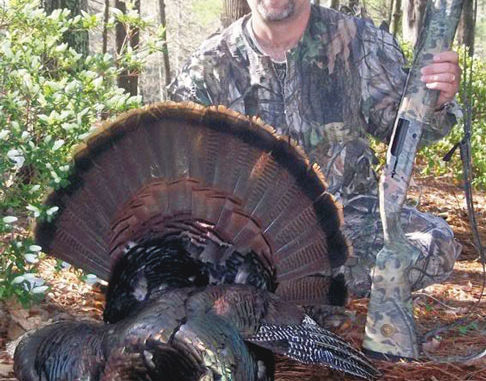
Will Tarheel State hunters break another record?
Brent Caton of Henderson experienced an opening day of the 2009 spring turkey season that was atypical for many Tarheel State hunters.But it also was a preview to another record-setting turkey harvest across the state.
“I was anticipating getting up early, but I got up only 15 minutes before legal shooting time,” said Caton. “I had to make a mad dash to the woods, so I was blessed to be able to hunt near my home.”
The hardwoods where he hunted had a power line through the middle plus a couple of fire breaks, good strutting areas for gobblers. Standing near one of the fire breaks, Caton gave a hen call.
“I was cut off immediately by a bird double-gobbling within 60 yards of me,” he said. “The only thing I could do was grab the closest tree.”
Caton hunkered down against an oak while readying his 12-gauge Mossberg shotgun, loaded with No. 5 HeviShot in 3½-inch shells.
“I gave one more set of calls, and a gobbler stepped out of some heavy stuff into the firebreak 15 yards in front of me,” he said. “I watched him strut and drum as long as I could stand it, then I put him down with one shot.”
Caton’s gobbler weighed 22½ pounds, had a 9-inch beard and 1-inch spurs. It had taken less than 30 minutes for the Vance County hunter to down the bird, which meant his gobbler was one of the first harvested during the 2009 season.
Enough hunters filled turkey tags last year — albeit not as quickly as Caton — to set another harvest record. North Carolina hunters sent 12,579 wild-turkey harvest reports to the N.C. Wildlife Resources Commission. That number eclipsed 2008’s total of 11,313 birds, an 8.9-percent increase and 2,497 turkeys more than were killed in 2007. Only 2006, with a reported harvest of 11,706 came close to 2009’s harvest, the highest since the Commission began keeping those records in 1982.
So where should enterprising gobbler chasers head this year in North Carolina, and can hunters expect a similar season?
What follows is a look at last year’s harvest and other information that should give turkey hunters a good idea of where to go in 2010 to punch their gobbler tag.
Top counties
Halifax County, which lies along the Roanoke River drainage, an area that’s been among North Carolina’s best turkey-hunting regions for years, led the state last spring. Not only did Halifax rank No. 1 with 426 tagged birds, but it had the state’s largest numerical increase over 2008 with an additional 95 turkeys harvested.
Neighboring Northampton County ranked second with 418 birds. Halifax and Northampton often swap first and second place at the top of the harvest list. Northampton was No. 1 in 2008 with 392 gobblers tagged, but its increase for 2009 was only 26 birds.
Clearly, those two counties should be among the top spots to find wild turkeys during this year’s April 10-May 8 season.
Hunters also don’t necessarily need access to private land to hunt turkeys in Halifax or Northampton, because both counties contain sections of the Roanoke River Wetlands and National Wildlife Refuge Game Lands, where permit hunting is allowed. Bertie County, which also contains sections of the Roanoke River Game Land, ranked 10th in 2009 with 266 turkeys taken.
“Those areas have strong deer and turkey harvests because of good habitat,” said Evin Stanford, the Commission’s big-game biologist. “They still have growing turkey populations and growing numbers of turkey hunters, and that’s what I suspect is driving harvest counts.”
Three northern piedmont counties rated high in 2009’s harvest, including Rockingham (third with 385 birds), Stokes (fourth, 329) and Caswell (fifth, 325).
Wilkes County, in the mountainous northwestern corner, was sixth in 2009 with 321 gobblers, while Rowan County of the western Piedmont was seventh with 279. Rutherford County in the foothills was eighth at 277, with Bladen County in southeastern North Carolina ninth at 269, followed by Bertie.
More turkeys everywhere?
With turkey re-stocking completed by the Commission several years ago, Stanford explained why piedmont and northwestern counties have high harvests.
“A lot of the (harvest) increase likely is being driven in some piedmont and other western counties by expansion of the turkey population,” he said. “Turkeys are moving into new areas where hunters can get at them, and there are more hunters in the piedmont and west than the east.”
A 2007 survey by the Commission showed 72,609 turkey hunters in North Carolina.
However, even with piedmont, foothills and northwestern regions leading 2009’s spring harvest, the greatest numerical jump occurred at eastern counties — including seven of the 10 largest increases.
The inference for hunters this year is that, coupled with a relatively low overall harvest, eastern turkeys are under-hunted.
Game lands birds
Western North Carolina, with its one million acres of game lands (most in the Pisgah and Nantahala national forests), almost always will have the top game-lands turkey harvests in North Carolina because there’s so much land to hunt.
But getting within shotgun range of a mountain gobbler isn’t easy, often requiring long hikes up and down mountainsides.
Macon County, with 41 tagged western turkeys, led game-lands harvests in 2009. Other western counties home to portions of the two national forests dominated the top 10.
However, for a single game land located in one small county, the northern piedmont’s Caswell is probably a good bet. Once a statewide magnet for turkey hunters, pressure has eased recently with the expansion of birds into surrounding counties. Still, last season, hunters tagged 33 gobblers on the Caswell Game Lands.
Hunters took 27 turkeys on game lands in Montgomery County, the only county in the top 10 besides Caswell not located in the west. Montgomery’s great turkey range is inside the Uwharrie National Forest. The only drawback is heavy hunting pressure, especially early in the season, because it is within easy driving distance of metropolitan areas such as Charlotte, Greensboro. High Point and Winston-Salem
Zone harvests
Even with the boost in 2009 harvests in seven counties, the Commission’s East zone (32 counties) had the overall lowest harvest in 2009 with 3,202 tagged turkeys. Meanwhile, the Central zone (30 counties) led the state with 4,691 reported gobblers; the Western zone (32 counties) was second with 4,686 tagged birds.
But Stanford said comparing total harvests in a county in a given zone isn’t the most-accurate way to determine where turkey hunters should go this spring.
“Other factors are involved, such as land mass and hunting interest,” he said.
Stanford said the west has 28 percent of the state’s turkey range, while the coastal region has 26 percent and the piedmont has 46 percent.
“I live in the eastern zone, Beaufort County, and we get turkeys moving into new areas here every year,” Stanford said. “But overall, turkey numbers and hunters are spotty in the east, even though we’re recruiting more turkey hunters. You might have a good concentration of turkeys in one county, but not as many in another.
“Also, another explanation for the relatively low harvest in the east is there are not as many turkey hunters as in the piedmont and west. Turkey (hunting) really hasn’t caught on, maybe because people don’t have as many (places) to hunt.”
That’s probably because eastern habitat is dominated by rivers, streams, swamps, pocosins, pine forests and thickets. Cleared agricultural areas tend to be on larger tracts of land, which means more turkey territory is concentrated in the hands of fewer landowners who may be reluctant to grant permission to hunt. But in the west and piedmont, hardwoods are more widespread, pines aren’t as prominent, and private acreage typically comes in smaller parcels.
“In the mountains, which are relatively open with big national forests, turkeys are scattered everywhere, not concentrated in pockets,” Stanford said.
Whether 2010’s spring gobbler season can be as productive as 2009 isn’t certain, but Stanford said hunters shouldn’t be pessimistic.
“We anticipate the upcoming season could be as good as the last,” Stanford said, “but whether or not we’ll set another harvest record, I can’t say. We’re hopeful we will.”

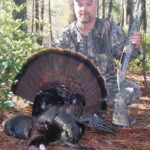
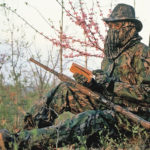
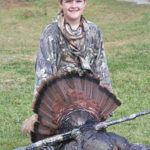
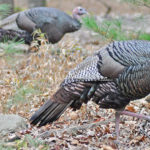
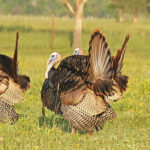
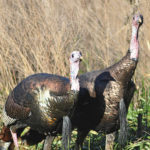



Be the first to comment